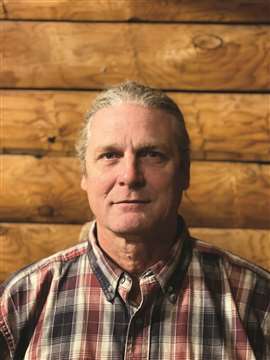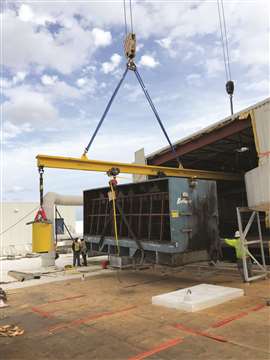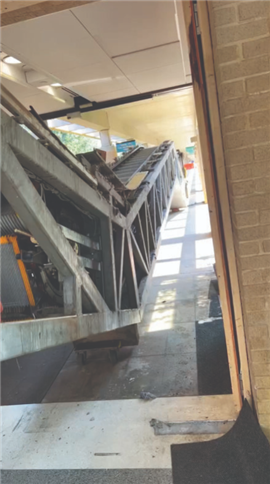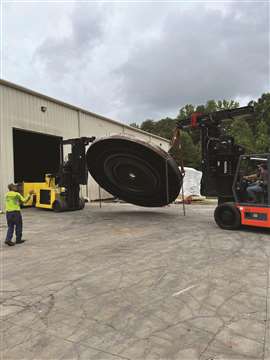Matthew Hinty: ‘Our job isn’t done until we all come home safe’
11 March 2024
Like many entrepreneurs in the specialized rigging and transportation industry, Matthew Hinty got his start at a very young age.
 Matthew Hinty, President, Advanced Rigging & Machinery Movers
Matthew Hinty, President, Advanced Rigging & Machinery Movers
“I’ve been moving machinery and in the rigging industry since I was 15 years old,” said Hinty, president of Advanced Rigging & Machinery Movers, based in Greenville, S.C. “The first company that I worked for, they cut a two-story house in half, loaded it onto trailers with a crane and moved it next door to the house I lived in, unloaded it with a crane and sat it onto a foundation.”
Hinty helped with scabbing the house back together and soon landed a job working for Mariano Brothers, which was the start of his career in the rigging industry.
“We did a lot a ‘old school’ moving back then,” he remembered. “We would skid machines and roll them on wooden rollers out of places and winch the skidded machines onto trucks utilizing planks and horses (a sawhorse that would support the plank in a couple locations to keep it from snapping into pieces).”
Hinty worked as a rigger, driver and crane operator after school and summers during school. He went on to manage the company’s rigging division for 12 years.
Then, he was offered the opportunity to work as a project manager for AME in Greenville, S.C. Five years later, Robert Campbell bought the Greenville operation and the company was renamed Campbell Crane. In 2003, Campbell Crane decided to focus on its crane division and get out of the rigging portion of the business.
“[At that point,] Advanced Rigging & Machinery Movers was formed by myself and Gene Burnett, to fill the void created for our customers,” said Hinty. “We started with two crews and spent any profit on acquiring equipment, tools, trucks that we foresaw would benefit our business as certain projects came about.”
Open doors
Some 21 years later, the company still serves the region surrounding Greenville, SC, covering South Carolina, North Carolina and Northwest Georgia.
“When one door closes, another one opens,” Hinty said. “We were both NCCCO-certified crane operators, and because we used industrial cranes on most of our jobs, we acquired a small fleet to offer these services to our customers and other mechanical and electrical contractors. We purchased our first hydraulic gantry for a two-year project that involved disassembling a dryer felt facility. Once you own a certain type of equipment, the need for it seems to make itself aware, to the point of offering gantry services. We found ourselves acquiring whatever our market required.”
Advanced Rigging is highly respected and Hinty has developed a rapport with customers who trust the company to perform the work they need safely, efficiently and with the utmost professionalism. With a long history in the region, Hinty and his team are proud of the work they perform. They are known for their ingenuity and ability to apply specialized solutions. I think you will be interested in what Hinty has to say.
 Removing an air handling device through a penthouse wall also called for the use of two cranes and a custom designed cantilever monorail beam.
Removing an air handling device through a penthouse wall also called for the use of two cranes and a custom designed cantilever monorail beam.
What distinguishes the company in the markets it serves?
We are distinguished by our experience in our region with a working knowledge of our customer’s facilities and their safety policies. We have a long history with them which provides us insights to their preferred ways of executing the work. It enables us to fulfill their needs and requests, in the way they require them to be performed. We also perform tasks in a way that have a minimum impact on their production schedule. We realize that it’s their revenue that provides capital to afford for our services and future purchases. We operate with the latest modern equipment and tools. Safety is always a primary in aspect of our performance. Our job isn’t done until we all come home safe.
In a competitive situation, what does the company bring to the table?
Efficiency through experience. We also have a considerable arsenal of equipment that we own to choose from. Because we own, we are familiar with how to use each piece of equipment, and use it properly. Our truck drivers primary task is transporting our equipment from yesterday’s job to tomorrow’s job, so most of the time our equipment is there from the day before – which comes close to eliminating any delays due to traffic or mechanical delays. And if a job delays or postpones, its not a huge impact to our schedule, because I can reroute the crew to another job where I can send other equipment. Our volume of equipment combined with our logistical setup keep us competitive.
What is the company’s sweet spot? Are jobs ever the same?
Our sweet spot is experience with utilizing old school methods combined with modern solutions. We have worked in all facets of the industry for over 40 years, so we bring that experience of knowing what works best, in our daily activities to find the most effective and efficient way to do the task at hand. Jobs are similar but different in the aspect that even though it’s the same job, there are different obstacles and different environments. Our methods are the same, but our solutions can vary based on that. Like no sporting event is the same, because the players, weather, turf, injuries, officials are different, all have an impact that make it a different game.
What is it that keeps you engaged in this industry?
The fact that every day is different. There is a challenge around every corner.
 Replacing an escalator at a hospital was complicated because the original escalators were installed when there was no roof on the building.
Replacing an escalator at a hospital was complicated because the original escalators were installed when there was no roof on the building.
What would you say are the three most complicated jobs your team has performed?
The first was removing two existing escalators and installing two new ones from a local hospital. When the escalators were originally installed, there was no roof. They were picked off a truck, put in place with a crane and the hospital was built around it including ductwork, pipes in the ceiling and below the roof. We could not remove the roof and infrastructure (utilities) in the ceiling, so we had to come up with another way. We created a monorail system. Using a 400-ton crane to set two 55-foot beams on top of the roof supported by the four building columns, set a 25-foot beam perpendicular onto those beams, then by removing two of the windows underneath, creating an opening to slide another 25-foot beam through the opening and suspending from the top 25-foot beam by chain falls on each side. Then we brought a 45-foot beam inside the atrium with our forklift to sit on top of the 25-foot beam inside the room on one end and sit onto one our gantry legs on the other end. We then installed chain falls coupled with beam trolleys on each end to rig to each escalator, hoist up out of the stairway and transfer out the doors. We did the same process in reverse to transfer the new escalators back into the stairway and set.
The second was removing an air handling device through a penthouse wall utilizing two cranes and a cantilever monorail beam that we designed. We couldn’t utilize the floor where it was sitting for support to remove. So, we stabbed our beam through the opening with one crane, supported the beam on the inside through with another crane hoisting through an opening in the roof. We lifted the unit up with a chain fall/trolley combination, then transferred out of the penthouse on our monorail to the point where the load’s center of gravity was under the two lifting points supporting by the first crane, then removing beam and unit from roof. Then we repeated the process in reverse to install the replacement unit.
The third was inverting a 70,000-pound, 16-foot diameter table to fit through a 14-foot doorway. This wasn’t a difficult job other than it’s not an everyday job. The planning and players involved need to be more experienced than your ‘everyday Joe.’ We lifted the table with a 40/60 with boom, and a 60/80 with boom and did the math to figure what the length of rigging needed be to create the perfect angle where we were less than 14-feet wide and no higher than 14-feet tall to be able to get through the door.
To perform the work you do, you have to have a lot of equipment. What are the most useful pieces of equipment in your fleet and why?
It boils down to having two essential tools – a lifting device and a transport device. A lifting device can be as simple as a lever bar, a jack, forklift, crane, hoist, gantry, etc. A transport device can be a piece of pipe, a roller, a conveyor, a dolly, a wagon, a trailer, an air float pad, a trolley or an object that slides upon something. Jack and dollies (skates) are our primary first tools. The remainder just expand upon them.
 Inverting a 70,000-pound, 16-foot diameter table to fit through a 14-foot doorway wasn’t a difficult job, but “the planning and players needed to be more experienced than your everyday Joe.”
Inverting a 70,000-pound, 16-foot diameter table to fit through a 14-foot doorway wasn’t a difficult job, but “the planning and players needed to be more experienced than your everyday Joe.”
How do you decide when to add new equipment to your fleet?
As we take on newer projects, we will look at the volume of utilization. If the most effective way to perform the task is by utilizing a newer method of equipment, that plays a large factor in the decision to make that purchase. Because we’ve collected an array of equipment, we have many assets to draw from, first. Most of our new equipment purchases are upgrades to some of our older equipment. Safety and ergonomics play a major role in our decisions also. For instance, we have a set of aluminum dollies in our list that have a capacity of 100,000 pounds each but only weigh 45 pounds.
What are the trending industries in terms of machinery moving?
Battery plants, automotive, aerospace, chemical and distribution companies in our region.
What are particular challenges that companies like Advanced Rigging & Machinery Movers currently face?
The biggest challenge is a qualified labor shortage. We have an intense amount of training and orientation for our vast customer base that add to the expense of a new employee, as well as current employees. To spend a fortune on someone who only lasts a few weeks, is very frustrating and expensive. And if the new employee has an issue and doesn’t follow the rules, it could impact us in a bad way with our customers.
How do you attract and retain workers?
Our company is operated like a family. After someone has worked for us for a few months, he or she is taken under our wing. For the most part, we don’t travel any further than a three-hour radius of Greenville, S.C., so 99 percent of the time our employees are home every night with their families. We compensate above market and reward them annually. Our hiring is mainly word of mouth, friends and family. We also attract workforce when we are in certain environments, when what we do every day, looks attractive to others.
What is your business philosophy?
We believe in being part of our community where we are here to service the local community and we grow as our local companies grow. Just like there is a grocer, a policeman, a fireman, we are your local rigger that you can count on to be there, as a kind of loyalty that’s reciprocated.
What do you do when you are not working?
I enjoy spending time with family and friends, travel, good food and drink and music.
STAY CONNECTED


Receive the information you need when you need it through our world-leading magazines, newsletters and daily briefings.




